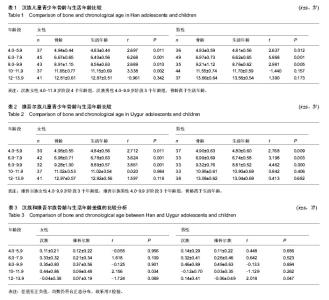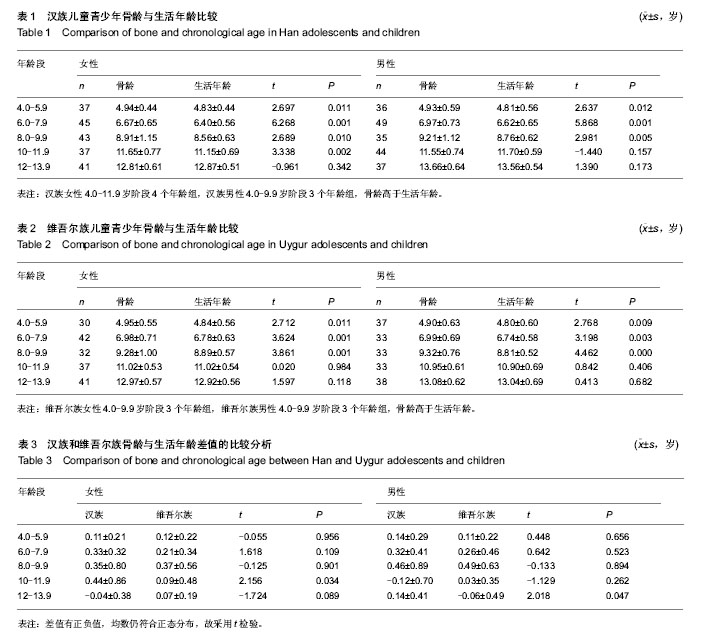| [1] 张绍岩,刘丽娟,花纪青,等.青少年手腕骨骨龄与生活年龄的差异观察[J].中国法医学杂志,2009,24(1):18-20.
[2] 席焕久.人的骨骼年龄[M].沈阳:辽宁民族出版社,1997:77-119.
[3] 潘复平,张国栋.骨龄与青春期发育关系的追踪观察[J].中华预防医学杂志.1985,19(2):79-81.
[4] 林洪宜,张建珺.广州市越秀区儿童骨龄分析[J].大家健康杂志.2014,3(8):30-31.
[5] Xi HJ.Roche AF.Difference between the hand-wrist and the knee in assigned skeletal age.Am J Phys Anthopo1. 1990;83: 95-102.
[6] Pyle SI,Hoerr NL.Radiographic atlas of skeletal development of the knee.A standard of reference.Charles C. Thomas, Springfield,III.1955.
[7] 许衍,王林,南京地区青少年儿童骨龄(手腕骨、颈椎骨)的研究[J].口腔医学杂志,2002,6(2):64-66.
[8] 苏莉,吕婴,王红梅.青春发育期颈椎骨龄计算方法的探讨[J].中华口腔医学杂志,2006,41(12):728-729.
[9] 阿不都吉里力,阿不都克里木,李学刚,等.男性青少年骨盆X线片骨骺融合增龄性变化的初步观察[J].新疆医科大学学报,2010, 33(8):947-949.
[10] 郭静.骨龄检测的方法及其应用[J].实用预防医学, 2009,12(6): 1995-1996.
[11] 叶义言.中国儿童骨龄评分法[M].北京:人民卫生出版社. 2005:1-8.
[12] 村田光範.骨龄评价的问题[J].国外医学:儿科学分册, 1992, 19(2): 89-92.
[13] 国家体育总局群体司.2000年国民体质监测报告[M].北京:北京体育大学出版社,2002:10-15.
[14] 林琬生,胡承康.中国青年生长发育环境差异的研究[J].人类学学报,1990,9(2):152-159.
[15] 张绍岩,马振国,韩一三, 等.中国5城市儿童青少年手腕骨发育差异对年龄推测影响[J].中国法医学杂志,2009,24(2):99-103.
[16] Schmeling A.Grundmann C,Fuhrmann A,et al.Criteria for age estimation in living individuals.Int J Legal Med. 2008;122: 457-460.
[17] 刘志霞,程晓光,等.儿童及青少年左右手X线骨龄对比研究[J].中华放射学杂志,2013,12(12):1070-1073.
[18] Ritschl E,Wehmeijer K,DE Terlizzi F,et al.Assessment of skeletal development in preterm and term infants by quantitative ultrasound.Pediatr Res.2005;58(2):341-346.
[19] Aicardi G,Vignolo M,Milani S,et al.Assessment of skeletal maturity of the hand-wrist and knee:A comparison among methods.Am J HumBiol.2000;12(5)610-615.
[20] Y/T001-92.中国人手腕骨发育标准CHN法[S].
[21] 张绍岩,刘丽娟,张继业,等.RUS.CHN图谱骨龄评价法用于推侧青少年年龄[J].中国法医学杂志,2009,24(4):249-253.
[22] 李永敬,梁景清,等.吕梁地区青少年骨龄的调查研究[D].山西:山西医科大学,2010.
[23] 叶广俊.儿童少年卫生学[M].4版.北京:人民卫生出版社,1999:63.
[24] 刘宝林,欧阳镇,王志强,等.学龄儿童骨龄发育的年代变化[J].中华预防医学杂志社,1991,25(6):385.
[25] Himes JH.An early hand-wrist atlas and its imp locations for secular change in bone age.Ann Hum Biol.1984;11:71-73.
[26] 张一兵,李铁民,王石清,等.中国人骨发育30年比较[J].天津体育学院学报,1997,12(1):28-31.
[27] 王建基, 高永辉.新疆汉民族饮食文化变迁及原因分析[J].中国社会科学:汉文版,2012,6(6):205-207.
[28] 席焕久.人的骨骼年龄[M].沈阳:辽宁民族出版社,1997:24-43.
[29] 李春山,李长勇,席焕久,等.拉萨藏族青少年手腕部骨龄发育评价[J].中国临床康复,2005,9(23):36-38.
[30] 董建军,刘丰春.烟台地区现代青少年骨龄的调查研究[J].中国康复理论与实践,2006,4(12):804-806.
[31] 任甫,李长勇,习焕久,等.RWT法评价拉萨藏族儿童青少年膝部骨龄[J].解剖学杂志,2006,29(6):774-776.
[32] 李春山,李长勇,任甫,等.那曲地区藏族青少年腕部骨龄评价[J].解剖学杂志,2006,29(4):414-416.
[33] 何晓芬,唐桂波,雷志毅,等.西宁市青少年生长发育与骨龄的调查研究[J].高原医学杂志,2010,20,(4):50-52.
[34] 张绍岩,马振国,韩一三,等.中国5城市儿童青少年手腕骨发育差异对年龄推测影响[J].中国法医学杂志,2009,24(2):100-103.
[35] 陈世贤.法医人类学[M].北京:人民卫生出版社,1998:45.
[36] 钱立,徐坚民,王国红,等.手腕部位置及角度的变化对TW2和CHN骨龄测评法骨骺分期准确性的影响[J].放射学实践. 2006, 21(4):407-408.
[37] Schmeling A,Schulz R,Reisinger W, et al.Studies on the time frame for ossification of medial clavicular epiphyseal cartilage in conventional radiography.Int J Legal Med,2004,118:5-8.
[38] Schmidt S,Baumann U,Schulz R,et al.Study of age dependence of epiphyseal ossification of the hand skeleton. Int J Legal Med,2008,1 22:51-54. |

